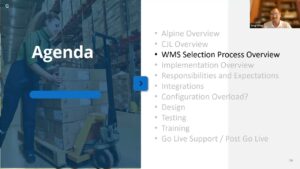You’ve just completed the monumental task of selecting a Warehouse Management System (WMS). It’s all smooth sailing from here, right? Alas, no. Now comes the WMS implementation, which may be one of your most critical responsibilities as a supply chain leader. And while it may be tempting to assume the implementation will be taken care of by the WMS vendor, that simply isn’t the case. While the vendor takes care of many tasks during an implementation, your responsibilities as a client are far more involved.
Here’s an overview of what to expect during a WMS implementation. The more you know, the better prepared you’ll be for one of the biggest tasks of your career.
WMS Implementation – Preparation
While the vendor will be focused on outlining all the steps needed for a smooth WMS implementation, the client will gather critical data. This begins with clearly defining expectations for the WMS project, including goals, timeline, and budget. To provide the vendor with a full picture, it’s the client’s responsibility to outline problem areas that need attention, explain operational processes, detail necessary interfaces needed, select a go-live date, create a go-live checklist, and so much more.
The preparation process also involves putting together a team that will be dedicated to the WMS implementation. Appoint a Project Manager (PM) to serve as the single point of contact between your organization and the vendor, ensuring that all information, data, and deliverables are tracked. This PM will work closely with a team of subject matter experts dedicated to the project. Their expertise should cover every department of the warehouse, including warehouse/operations, sales, IT, customer service, finance, quality assurance/quality control, and manufacturing.
Testing & Training
One of the core functions of the implementation phase is testing. The vendor will take care of the initial testing phase, known as Unit Testing, but all other tests are managed by the client. These include:
- System Integration Testing (SIT)
- User Acceptance Testing (UAT)
- Readiness Testing (RT)
These tests require accurate test scenarios and scripts, along with a detailed list of all the tasks and expected results. Just as critical as testing is training. A designated team member from the pre-implementation phase will receive system training from the vendor and be responsible for training the rest of the staff.
Effective training during a WMS implementation is of crucial importance. The quality of this training will determine how smoothly the rest of the implementation goes, and how quickly the rest of the staff adopts the new system. The better the training documentation, the better your chances of having a seamless transition.
Go-Live
The go-live date is a pivotal moment. Both the client and vendor teams will be tackling various tasks to kick off the implementation. By this stage, the teams will have already identified who will be present for the go-live. As they gear up for the event, the client will need to consider how much time will be needed for the cutover, what the ramp-up plan is, when the best time to start the implementation is, and so much more.
Ensuring a Successful WMS Implementation
Clients bear a significant amount of responsibility during the implementation phase. To get a better understanding of what vendors are tasked with and what is expected of the client, download our white paper: WMS Implementations: Deciphering Vendor and Client Responsibilities. We pride ourselves on providing system implementation services that ensure successful WMS implementations. If you’re looking for expert assistance with your WMS implementation, we’re here to help.













